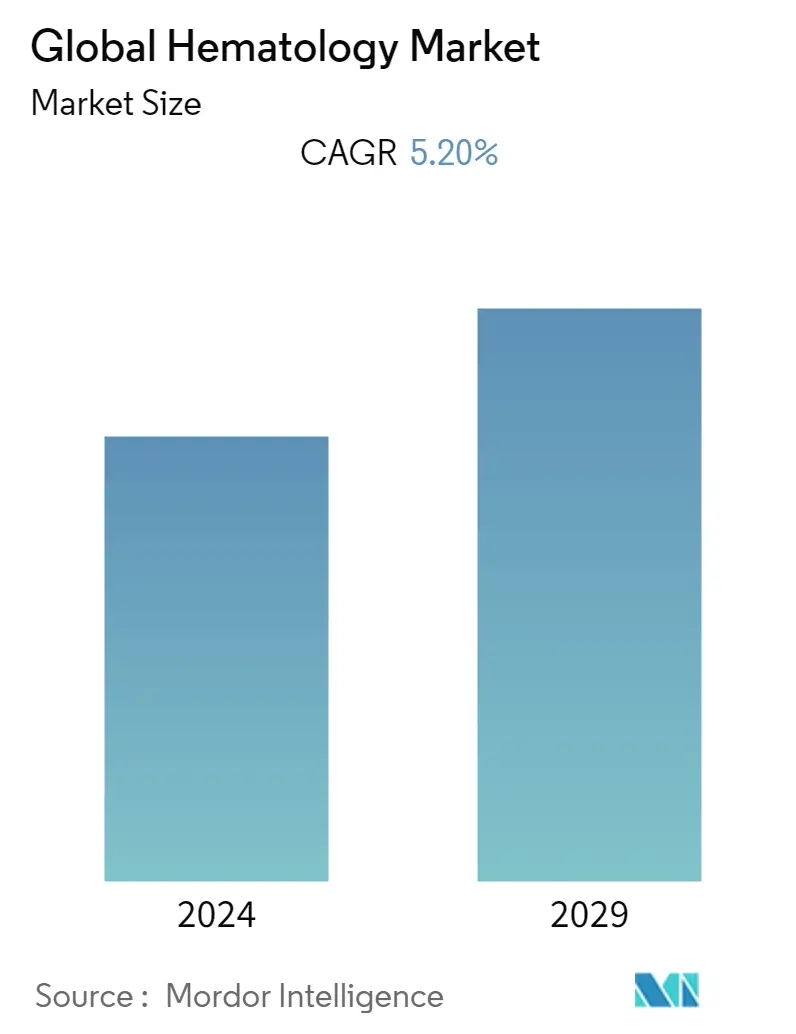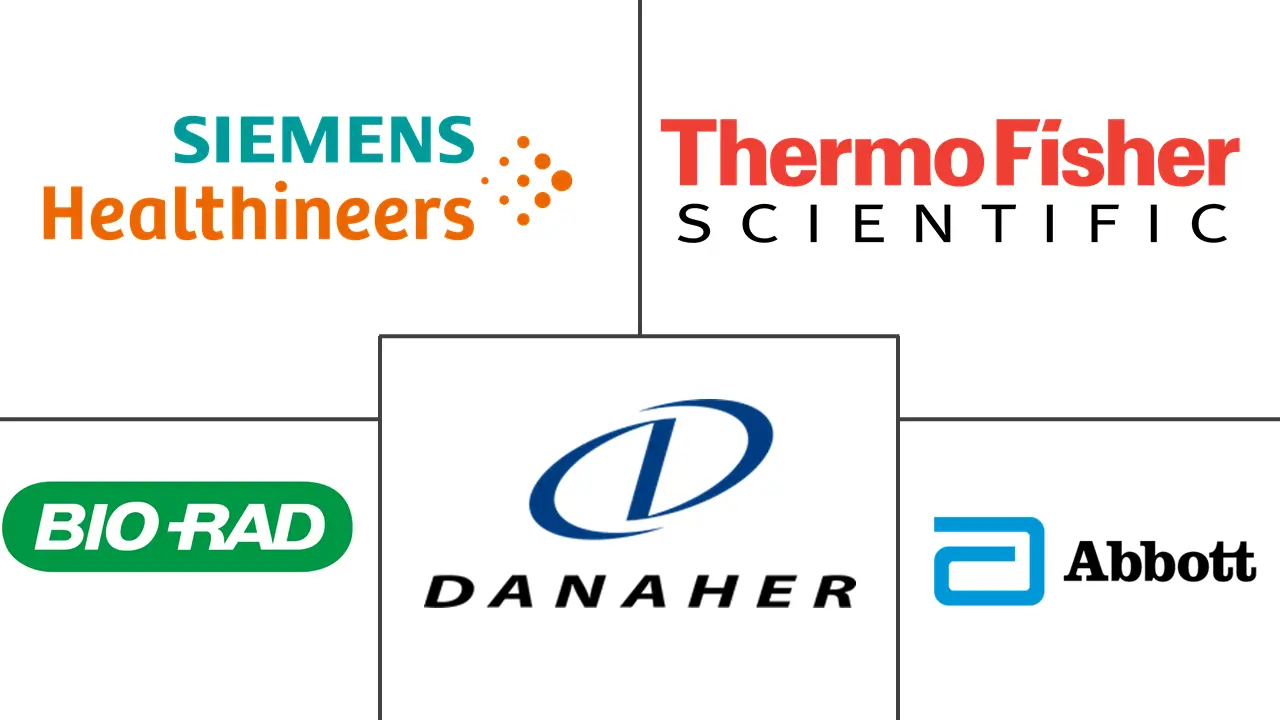Market Size of Global Hematology Industry

| Study Period | 2019 - 2029 |
| Base Year For Estimation | 2023 |
| Forecast Data Period | 2024 - 2029 |
| CAGR | 5.20 % |
| Fastest Growing Market | Asia Pacific |
| Largest Market | North America |
Major Players
*Disclaimer: Major Players sorted in no particular order |
Hematology Market Analysis
The hematology market is expected to record a CAGR of 5.2% over the forecast period (2022-2027).
The COVID-19 outbreak is expected to have a significant impact on the hematology market as there is an increasing focus on hematology parameters for the assessment of COVID-19 around the world, and many hospitals have started using instruments such as hematology analyzers to test and monitor COVID-19 patients. According to the research article published in the International Journal of Laboratory Hematology, 2020, a clinical hematology laboratory has a critical role in providing several useful prognostic markers such as lymphopenia, neutrophilia, leukocytosis, and thrombocytopenia, which are common findings in patients infected with SARS-CoV-2 virus. According to the report published in the American Society of Hematology 2021, Patients with COVID-19 and sickle cell disease (SCD) remained at a higher risk of hospitalization, pneumonia development, and pain when compared to Black people without SCD. As the people with SCD were at higher risk of developing other infections, it was important to monitor their health which has considerably impacted the market. Thus, the growing importance of hematological testing in COVID-19 infected patients is expected to surge the demand for hematology products and reagents across various end users, thereby significantly impacting the studied market's growth during the pandemic era.
The growth of the hematology market is attributed to the increasing incidences of blood disorders and other diseases, rapid technological advances in hematology, and the emergence of high throughput hematology analyzers. The increasing prevalence of chronic blood disorders is one of the major factors driving the market, as it is expected to drive the demand for hematology analyzers. Coagulation analyzers can accurately detect the clotting endpoint in various blood disorders, such as hemophilia. People can be affected by various types of blood conditions and blood cancers. Common chronic blood disorders include anemia, bleeding disorders such as hemophilia and blood clots, and blood cancers such as leukemia, lymphoma, and myeloma. As per the May 2022 update by the Center for Disease Control and Prevention, sickle cell disease (SCD) affects approximately 100,000 Americans. It occurs among about 1 out of every 365 Black or African American births. Early diagnosis and treatment are the best ways to protect the life of a patient with blood cell disorder.
Additionally, the technological advancements and product launches by key players have been driving the market growth. For instance, in June 2022, Thermo Fisher Scientific Inc. introduced the new EliA RNA Pol III and EliA Rib-P blood tests for aiding in the diagnosis of Systemic Sclerosis and Systemic Lupus Erythematosus (SLE), thus further expanding its comprehensive menu of automated connective tissue disease tests. According to an article 'RURAL Study to Use HemoScreen POC Hematology Analyzer' published in February 2021, the Risk Underlying Rural Areas Longitudinal Study (RURAL) was conducted to understand the health concerns facing people in rural communities who don't have the same healthcare access as urban parts. This study plans to deploy technology advanced HemoScreen hematology analyzers in the Mobile Examination Unit lab to test the performance characteristics of the HemoScreen in those setting. Thus, the research proving the efficacy of technologically advanced product will boost the ongoing innovation in the market, thus fueling the market growth. Thus, owing to the abovementioned factors, the hematology market is expected to witness significant growth over the forecast period. However, the high cost of the instruments and the low adoption of hematology analyzers in the emerging economies are anticipated to hamper the market growth in the coming years.
Hematology Industry Segmentation
As per the scope of the study, hematology is a branch of medicine that deals with blood and blood-related disorders. Hematology tests include various tests on the blood, blood proteins, and blood-producing organs to evaluate a variety of blood conditions, including infection, anemia, inflammation, hemophilia, blood-clotting disorders, leukemia, and the body's response to chemotherapy treatments. The scope of the study includes various instruments and reagents that are used in hematology testing. The hematology market is segmented by product (hematology analyzers, flow cytometers, coagulation analyzers, slide stainers, centrifuges, hemoglobinometers, and other products), reagents (coagulation reagents, flow cytometry reagents, immuno-hematology reagents, and other reagents), application (drug testing, auto-immune diseases, cancer, diabetes mellitus, infectious diseases, and other applications), end user (hospitals, clinical testing institutes, patient self-testing, and other end users), and geography (North America, Europe, Asia-Pacific, Middle East & Africa, and South America). The market report also covers the estimated market sizes and trends for 17 countries across major regions globally. The report offers the value (USD million) for all the above segments.
| By Product | |
| Hematology Analyzers | |
| Flow Cytometers | |
| Coagulation Analyzers | |
| Slide Stainers | |
| Centrifuges | |
| Hemoglobinometers | |
| Other Products |
| By Reagent | |
| Coagulation Reagents | |
| Flow Cytometery Reagents | |
| Immuno-hematology Reagents | |
| Other Reagents |
| By Application | |
| Drug Testing | |
| Auto-immune Diseases | |
| Cancer | |
| Diabetes Mellitus | |
| Infectious Diseases | |
| Other Applications |
| By End User | |
| Hospitals | |
| Clinical Testing Institutes | |
| Patient Self-testing | |
| Other End Users |
| Geography | ||||||||
| ||||||||
| ||||||||
| ||||||||
| ||||||||
|
Global Hematology Market Size Summary
The hematology market is poised for significant growth, driven by the increasing prevalence of blood disorders and technological advancements in hematology analyzers. The market's expansion is further fueled by the rising demand for hematology tests, particularly in the context of the COVID-19 pandemic, where hematological parameters have become crucial for patient assessment. The introduction of high-throughput analyzers and innovative products by key industry players has enhanced diagnostic capabilities, thereby boosting market growth. The market is characterized by a moderate level of competition, with major players like Abbott Laboratories, Bio-Rad Laboratories Inc., and Danaher Corporation actively engaging in strategic initiatives such as mergers, acquisitions, and product launches to strengthen their market positions.
In North America, particularly the United States, the hematology market is expected to experience robust growth due to the high incidence of blood disorders and the rapid adoption of advanced diagnostic technologies. The region's market is further supported by regulatory approvals for innovative products and the increasing demand for blood tests. Despite the promising growth prospects, challenges such as the high cost of instruments and limited adoption in emerging economies may hinder market expansion. Nonetheless, ongoing research and development activities, along with strategic partnerships, are anticipated to drive the market forward, ensuring a positive outlook for the hematology industry over the forecast period.
Global Hematology Market Size - Table of Contents
-
1. MARKET DYNAMICS
-
1.1 Market Overview
-
1.2 Market Drivers
-
1.2.1 Increasing Incidences of Blood Disorders and Other Diseases
-
1.2.2 Rapid Technological Advances in Hematology
-
1.2.3 Emergence of High Throughput Hematology Analyzers
-
-
1.3 Market Restraints
-
1.3.1 High Cost of Instruments
-
1.3.2 Low Adoption of Hematology Analyzers in Emerging Economies
-
-
1.4 Porter's Five Forces Analysis
-
1.4.1 Threat of New Entrants
-
1.4.2 Bargaining Power of Buyers/Consumers
-
1.4.3 Bargaining Power of Suppliers
-
1.4.4 Threat of Substitute Products
-
1.4.5 Intensity of Competitive Rivalry
-
-
-
2. MARKET SEGMENTATION (Market Size by Value - in USD Million)
-
2.1 By Product
-
2.1.1 Hematology Analyzers
-
2.1.2 Flow Cytometers
-
2.1.3 Coagulation Analyzers
-
2.1.4 Slide Stainers
-
2.1.5 Centrifuges
-
2.1.6 Hemoglobinometers
-
2.1.7 Other Products
-
-
2.2 By Reagent
-
2.2.1 Coagulation Reagents
-
2.2.2 Flow Cytometery Reagents
-
2.2.3 Immuno-hematology Reagents
-
2.2.4 Other Reagents
-
-
2.3 By Application
-
2.3.1 Drug Testing
-
2.3.2 Auto-immune Diseases
-
2.3.3 Cancer
-
2.3.4 Diabetes Mellitus
-
2.3.5 Infectious Diseases
-
2.3.6 Other Applications
-
-
2.4 By End User
-
2.4.1 Hospitals
-
2.4.2 Clinical Testing Institutes
-
2.4.3 Patient Self-testing
-
2.4.4 Other End Users
-
-
2.5 Geography
-
2.5.1 North America
-
2.5.1.1 United States
-
2.5.1.2 Canada
-
2.5.1.3 Mexico
-
-
2.5.2 Europe
-
2.5.2.1 Germany
-
2.5.2.2 United Kingdom
-
2.5.2.3 France
-
2.5.2.4 Italy
-
2.5.2.5 Spain
-
2.5.2.6 Rest of Europe
-
-
2.5.3 Asia-Pacific
-
2.5.3.1 China
-
2.5.3.2 Japan
-
2.5.3.3 India
-
2.5.3.4 Australia
-
2.5.3.5 South Korea
-
2.5.3.6 Rest of Asia-Pacific
-
-
2.5.4 Middle East and Africa
-
2.5.4.1 GCC
-
2.5.4.2 South Africa
-
2.5.4.3 Rest of Middle East and Africa
-
-
2.5.5 South America
-
2.5.5.1 Brazil
-
2.5.5.2 Argentina
-
2.5.5.3 Rest of South America
-
-
-
Global Hematology Market Size FAQs
What is the current Global Hematology Market size?
The Global Hematology Market is projected to register a CAGR of 5.20% during the forecast period (2024-2029)
Who are the key players in Global Hematology Market?
Danaher Corporation, Abbott Laboratories, Bio-Rad Laboratories Inc., Thermo Fisher Scientific Inc and Siemens Healthineers are the major companies operating in the Global Hematology Market.

